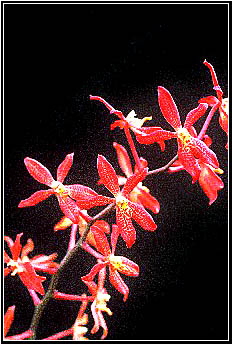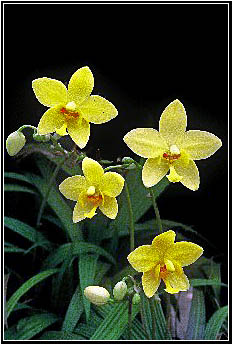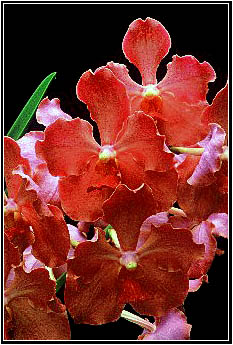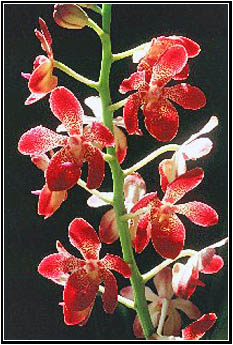ON: Dr. Tim Wing
Yam, could you give us an idea about your country, climate, geographical
conditions, size?
TWY: Singapore is located at ca. 1º north
of the equator, off the southern tip of the Malay Peninsula between
the South China Sea and the Indian Ocean. The nation consists of the
main island of Singapore and 58 nearby islands. The total land area
is ca. 690 km2. The whole island consists of mostly lowland. The highest
point is at Bukit Timah, which reaches an elevation of 165 m. The equatorial
climate has a relatively uniform temperature and high humidity. Average
daily temperatures fluctuate between 25.2ºC and 32ºC. Annual
rainfall is ca. 1700 mm, with the wettest months November–January.
ON:
How many species of orchids grow in Singapore?
TWY: Of the 221 species of native orchids recorded
in Singapore, more than 90% are endangered, vulnerable, rare, or extinct.
ON: In what kind of habitat, they grow?
TWY: Singapore is a modern city, yet it has many
interesting types of natural habitats. The heart of the main island
has a primary rain forest and a freshwater swamp forest. In addition,
some mangroves remain along the coast. Other habitats consist of secondary
forests, shrub, grasslands, and urban parks and fields.
ON:
Most of them are terrestrial or epiphyte?
TWY: Of the total number of native orchid species
in Singapore, ca. 75% are epiphytes, 25% are terrestrials.
ON:
Singapore Botanic Gardens is a traditional garden founded in 1859 and
the National Orchid Garden has opened on 20 October 1995. However the
orchid breeding programme has started a long time ago, hasn't it?
TWY: The orchid breeding programme in the Gardens
was initiated by R. E. Holttum.
He used the new (at the time) method of asymbiotic orchid seed germination
developed by Professor Lewis Knudson to germinate seeds on sterile culture
media. By the end of 1929, he reported that he was able to germinate
seeds of Dendrobium crumenatum, Phalaenopsis violaceae, Vanda hookeriana,
Vanda teres, Spathoglottis plicata, and one dozen other hybrids.
Holttum flowered Spathoglottis Primrose (Spathoglottis aurea
x Spathoglottis plicata), his first hybrid, in 1931.
ON: Singapore Botanic Gardens have created many hybrids. What can you
say about the importance of those hybrids?
TWY: The Gardens started naming new hybrids after
VIPs and visiting dignitaries. In 1956, the first VIP orchid Aranthera
Anne Black (Arachnis Maggie Oei x Renanthera coccinea)
was named after Lady Black, wife of the former Governor of Singapore,
Sir Robert Black. This programme is still going on. Some of the recent
hybrids named after dignitaries include Vandaenopsis Nelson Mandela
(Vanda Mas Los Angeles x Paraphalaenopsis labukensis),
Mokara Zhu Ronji (Arachnis Maggie Oei x Ascda Guo Chia
Long) and Kagawara Megawati Soekarnoputri (Renanthera
Tom Story Ascocenda Fiftieth State Beauty). Many hybrids produced
by the Gardens became important in the multi-million dollar orchid cut-flowers
export market. Examples are: Aranda Deborah (Arachnis hookeriana
x Vanda lamellata), Aranda Majula (Arachnis
Maggie Oei x Vanda insignis), and Aranthera Anne Black
(Arachnis Maggie Oei x Renanthera coccinea). In the early 1980s,
aware of the constant demand for new orchid hybrids, the Orchid Programme,
led by Dr. Tan Wee Kiat, once again geared itself towards breeding exclusive
hybrids to be displayed at the Gardens and for the local orchid industry.
In 1995, a 3-hectare National Orchid Garden was opened to showcase the
products of our breeding programme and our species collection. Orchid
hybrids are displayed in a beautifully landscaped environment.
ON: What kinds of improvements have been introducted?
TWY: Recently, we started to breed polyploid hybrids.
Most orchids have two basic sets (diploid, 2x) of chromosomes. Plants
that contain more than the basic two sets of chromosomes are considered
to be polyploids. The most common form of polyploidy is the doubling
of chromosome number from diploid (2x) to tetraploid (4x). Tetraploid
plants are usually more fertile (especially for intergeneric hybrids).
As a rule, they are also horticulturally more desirable than their diploid
counterparts. Flowers of tetraploids tend to have better texture, are
bigger and have more intense colouration. So far, several tetraploids
have flowered and the results are promising. We have produced hybrids
with exciting new colours as such orange and red antelope dendrobiums.
A dark chocolate-coloured Ascocenda flowered recently (it even
smells like chocolate!). We also use parents species that were seldom
used before such as Dendrobium singkawangense, Trichoglottis
loheriana, Vandopsis waroqueana, and hybrids of Bulbophyllum,
Coelogyne and Pecteilis. Some of these hybrids have flowered.
They are interesting and possess unique characteristics that are different
from the more common hybrids. We believe that these new hybrids will
lead us to new and exciting breeding directions.
ON:
You said that your breeding programme focuses in two major groups, dendrobiums
and vandaceous orchids. It means that you don't work species come from
another region?
TWY: We also work with species from the Americas.
ON: Thank you, Dr. Tim Wing Yam
|
|
|
|
|
Renachilus
Ricky Martin
|
|
Spath.
Lion of Singapore
|
|
|
|
|
V.
Tan Hoon Siang
|
Vananthopsis
Khoo Chin Hean
|
Photos by Tim
Wing Yam
|
Any
kind of reproduction (print, digital or anyone other) of any
type of material of this site - texts, layout, photos, images
and others - is strictly forbidden without previous written
permission by the authors.
|




